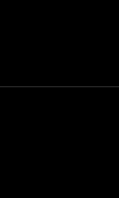
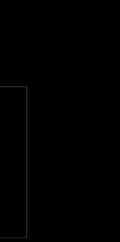

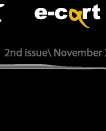






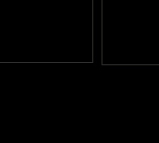







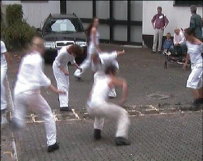
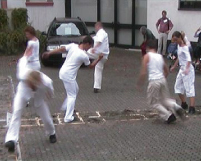
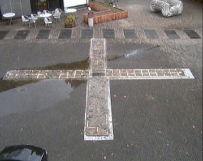

A small thing can sometimes become of unexpected importance. It seems that the anonymous, innocent and stupid gesture of stepping on public areas, where access is forbidden, damaging the constructions of public interest with no sanction upon it, is a constant problem. A general feeling of misconsideration towards other people's work, of lack of care about the street's image - dirty, with holes, filled with all kind of "marks" - makes us, the Romanians, behave irresponsibly and be always innefficient (since we're producing countable damages!).
I started by noticing traces of footsteps on concrete
blocks and I made a series of photographs (I've quickly made a roll-film in
my very neighbourhood), with which I participated at the 2001 Venice biennial,
within the "Context" project of Alexandru Patatics. In the same
year I was invited by the "Fabs" Foundation from Warszaw at the
"Atopos" event, that took place at Lods, in a disused plant from
the 19th century. In the context of an international participation, I built
an installation out of 50 concrete blocks put on an alley of 10 m long. The
public was invited, according to the project, to intervene, by stepping or
not on the surface of wet concrete. It was an attempt to re-start the accidental
gesture, by assuming it. Ever since, I keep seeing new marks of footsteps,
more and more expressive, on our streets, and that made me go on with my initial
project. I showed that this would be like a habit of South-East European populations
but I didn't notice it, not even, for exemple, in Ukraine, when I visited
the city of Lvov…
It has become obvious that the Romanians are the champions of this practice.
In 2003 I made the video Marks (7.15 min., sound), that
was presented in Ukraine, Venice and the US and now it's circulating.
In August - September 2003 there took place at Mainz/ Germany the art festival
"Towers of Babel", an annual event of contemporary art, where a
lot of artists, actors, musicians, dancers, writers, were invited. Taking
as a starting point the Biblical myth, the organizers wanted to experiment
the communication between artists coming from different cultures (Europe,
China, Africa), the communication between arts. Under the circumstances of
the present international context, can we, as people, find a common language?
Can we understand each other? Can we achieve (build) something together? Etc.
Is it possible that the art language/ languages contribute to the raising
of awareness regarding the condition of the contemporary civilized man…
1. My answer to the opportunity of being selected by
the curator Gunter Minas to take part in this show was an action, re-making
the project "Marks". I assumed that those who leave footsteps' traces
on the sidewalk do this in order to communicate… Consequently, let's
try to communicate through these marks (the public was informed that any trace
left there - the spot of the action was the State Museum in Mainz - is going
to be kept there for a long time).
The "warning" exhibited in the museum's courtyard said:
KEEP OFF THIS ALLEY OR STEP ON IT.
DO WHATEVER YOU LIKE.
BUT KEEP IN YOUR MIND THAT ANY TRACE YOU LEAVE THERE WILL STAY FOR A VERY
LONG TIME.
MARKS. COMMUNICATION. MAINZ, 2003.
2. The general subject being collaboration, interaction, diversity of means and languages, I decided to integrate an installation with a contemporary dance show and I worked together with a group of ballet dancers and a choreographer. I met Nancy Seitz-McIntyre, the curator of the dance section and the leader of the dance band, right before our meeting in Mainz, in August. We discussed general ideas and we tried to find out a convenient formula for what was called "Kunst Action", for a dance piece that was to be preserved in concrete blocks. The difficulty consisted in the requierement of 3 representations in 2 days, that was the repeating of the action and not an unique event as I had conceived it. More than this, it was a general repetition without public, a day before the opening. Finally, our work, a dance marking a concrete path, a dance lasting 5 minutes, was played 4 times, being one of the moments of a 2 hours show, when the audience was guided on a route crossing the inner and outer spaces of the museum. Each time, there appeared a sidewalk of 8.5 m x 08 m, made of 22 blocks, prepared for the 6 members of the ballet band to step on it in an urban dance, according to my concept.
In the end, we obtained 4 sidewalks arranged in the form of a cross (with no religious connotation), occupying an aprox.20 m x 20 m surface made of 88 concrete blocks. The music (modern and traditional percussion instruments) was produced by Ramesh Shotham and Beni Reimann. There danced: Constanza Pelecha Vela, Erick Patrith Jiminenez Vindas, Gilbert Buss, Ingo Schweiger, Jose Miguel Martin Agudo, Karen Piewig, Raquel Boti del Soto.
Teodor Graur
|
|
|
||||||||||||||||||||||||
|
|
 |
 |
|
||||||||||||||||||||||
 |
 |
|
|
||||||||||||||||||||||
 |
 |
|
|
||||||||||||||||||||||
 |
 |
 |
|
||||||||||||||||||||||
 |
|
|
|||||||||||||||||||||||
|
|
 |
|
|
||||||||||||||||||||||
 |
 |
|
|
||||||||||||||||||||||
|
|
|
|
|
 |
|
||||||||||||||||||||
 |
|
 |
|
||||||||||||||||||||||
 |
|
||||||||||||||||||||||||
|
|
|
||||||||||||||||||||||||
| |
|
||||||||||||||||||||||||
 |
|
||||||||||||||||||||||||
|
|
|
|
|||||||||||||||||||||||
|
|
|
||||||||||||||||||||||||
|
|
|
||||||||||||||||||||||||
|
|
 |
|
 |
|
 |
 |
|
||||||||||||||||||
|
|
|
|
|
||||||||||||||||||||||
|
|
|
|
|
|
|
|
|
|
|
|
|
|
|
|
|
|
|
|
|
|
|
|
|
|
|